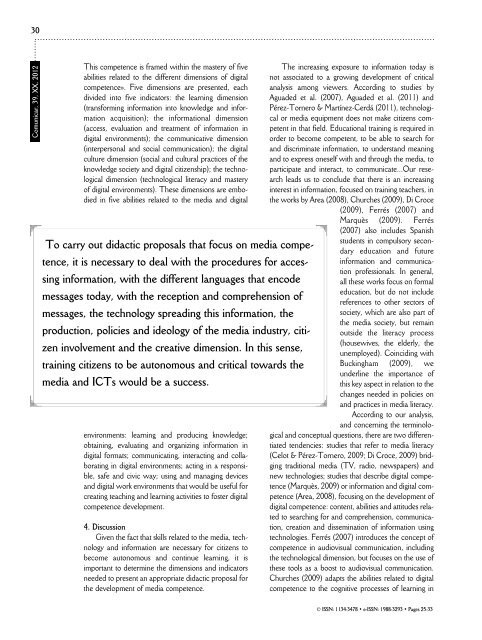Comunicar 39-ingles - Revista Comunicar
Comunicar 39-ingles - Revista Comunicar
Comunicar 39-ingles - Revista Comunicar
Create successful ePaper yourself
Turn your PDF publications into a flip-book with our unique Google optimized e-Paper software.
30<strong>Comunicar</strong>, <strong>39</strong>, XX, 2012This competence is framed within the mastery of fiveabilities related to the different dimensions of digitalcompetence». Five dimensions are presented, eachdivided into five indicators: the learning dimension(transforming information into knowledge and informationacquisition); the informational dimension(access, evaluation and treatment of information indigital environments); the communicative dimension(interpersonal and social communication); the digitalculture dimension (social and cultural practices of theknowledge society and digital citizenship); the technologicaldimension (technological literacy and masteryof digital environments). These dimensions are embodiedin five abilities related to the media and digitalTo carry out didactic proposals that focus on media competence,it is necessary to deal with the procedures for accessinginformation, with the different languages that encodemessages today, with the reception and comprehension ofmessages, the technology spreading this information, theproduction, policies and ideology of the media industry, citizeninvolvement and the creative dimension. In this sense,training citizens to be autonomous and critical towards themedia and ICTs would be a success.environments: learning and producing knowledge;obtaining, evaluating and organizing information indigital formats; communicating, interacting and collaboratingin digital environments; acting in a responsible,safe and civic way; using and managing devicesand digital work environments that would be useful forcreating teaching and learning activities to foster digitalcompetence development.4. DiscussionGiven the fact that skills related to the media, technologyand information are necessary for citizens tobecome autonomous and continue learning, it isimportant to determine the dimensions and indicatorsneeded to present an appropriate didactic proposal forthe development of media competence.The increasing exposure to information today isnot associated to a growing development of criticalanalysis among viewers. According to studies byAguaded et al. (2007), Aguaded et al. (2011) andPérez-Tornero & Martínez-Cerdá (2011), technologicalor media equipment does not make citizens competentin that field. Educational training is required inorder to become competent, to be able to search forand discriminate information, to understand meaningand to express oneself with and through the media, toparticipate and interact, to communicate...Our researchleads us to conclude that there is an increasinginterest in information, focused on training teachers, inthe works by Area (2008), Churches (2009), Di Croce(2009), Ferrés (2007) andMarquès (2009). Ferrés(2007) also includes Spanishstudents in compulsory secondaryeducation and futureinformation and communicationprofessionals. In general,all these works focus on formaleducation, but do not includereferences to other sectors ofsociety, which are also part ofthe media society, but remainoutside the literacy process(housewives, the elderly, theunemployed). Coinciding withBuckingham (2009), weunderline the importance ofthis key aspect in relation to thechanges needed in policies onand practices in media literacy.According to our analysis,and concerning the terminologicaland conceptual questions, there are two differentiatedtendencies: studies that refer to media literacy(Celot & Pérez-Tornero, 2009; Di Croce, 2009) bridgingtraditional media (TV, radio, newspapers) andnew technologies; studies that describe digital competence(Marquès, 2009) or information and digital competence(Area, 2008), focusing on the development ofdigital competence: content, abilities and attitudes relatedto searching for and comprehension, communication,creation and dissemination of information usingtechnologies. Ferrés (2007) introduces the concept ofcompetence in audiovisual communication, includingthe technological dimension, but focuses on the use ofthese tools as a boost to audiovisual communication.Churches (2009) adapts the abilities related to digitalcompetence to the cognitive processes of learning in© ISSN: 1134-3478 • e-ISSN: 1988-3293 • Pages 25-33
















